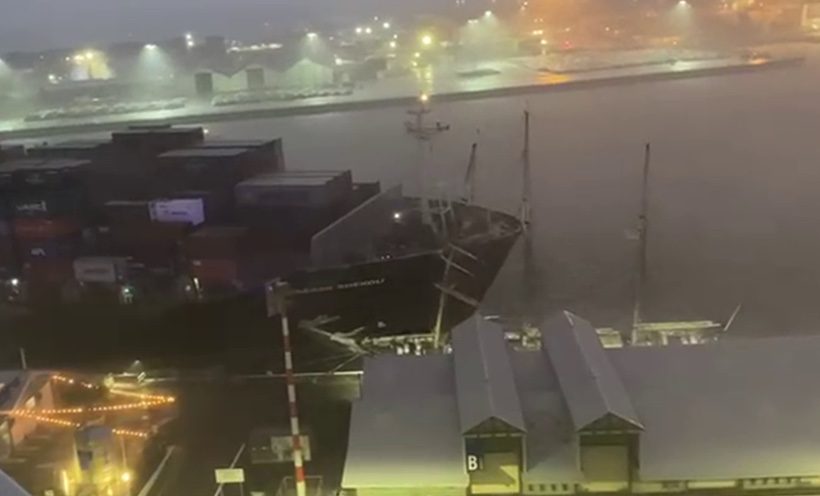A deadly engine room fire aboard the dredging vessel Stuyvesant last November has revealed critical lessons about maintenance procedures and machinery startup protocols, according to a newly released National Transportation Safety Board investigation report.
The November 2, 2024 fire in the St. Johns River near Jacksonville, Florida, claimed one life and caused an estimated $18 million in damage to the 392-foot hopper dredger.The victim, a crewmember who was in the machinery control room when the fire erupted, was removed by the shipboard emergency squad but later pronounced dead at a local hospital.
Investigators determined that the fire resulted from a catastrophic chain of events triggered by what should have been routine maintenance. The probable cause, according to the NTSB, was “lube oil spraying from an auxiliary diesel engine (generator) and igniting off a nearby running diesel engine, due to engine crewmembers not reinstalling a plug after routine maintenance in accordance with the engine manufacturer’s instructions and not thoroughly inspecting the port auxiliary engine before initially starting it.”
The crew had just completed maintenance on one of the vessel’s two 2,442-horsepower Caterpillar 3512C auxiliary diesel engines, which included replacing fuel and lube oil filters and changing the lube oil in the sump.However, investigators discovered that the plug on the engine’s lube oil filter housing had not been reinstalled—it was later found sitting on a nearby storage cabinet.
When the first engineer started the engine remotely from the machinery control room, pressurized lube oil at approximately 65 psi sprayed from the open port in the filter housing onto the hot exhaust surfaces of an operating main engine below, which were between 614°F and 742°F—well above lube oil’s ignition temperature.Flames appeared less than a minute after startup.
A critical factor in the casualty was the decision to start the engine remotely rather than locally. As the NTSB report notes, “If the engine had been started locally, a crewmember would have been near the engine for the start sequence” and “could have identified a reduced discharge of lube oil through the open internally threaded port at the top of the lube oil filter housing and could have taken action to stop the start sequence.”
The report emphasizes that starting engines locally after maintenance “gives crewmembers the opportunity to immediately verify that the engine is operating satisfactorily (to manufacturer’s specifications) with no visible fuel, lube oil, or water leaks, and has no atypical noises or vibrations that require it to be stopped.”
The investigation revealed that multiple maintenance procedures were not followed according to manufacturer instructions. Beyond the missing plug, the lube oil filler cap was also left open.More significantly, crewmembers failed to conduct the walk-around inspection recommended by the engine manufacturer before starting the engine.
The NTSB noted that disruptions during the maintenance process may have contributed to the oversights. The engineering crew had initially planned to perform the work the day before but delayed due to limited time. On the day of the fire, the three-person maintenance team’s composition changed when one member left due to illness.
“A disruption during the performance of a job that requires sequential tasks can lead to steps in the sequence being overlooked or missed, especially in teams where individual roles and expectations may not be clearly defined,” the report states.
The crew’s emergency response likely prevented an even worse outcome. The port auxiliary engine was stopped about 2.5 minutes after the fire was discovered, cutting off the primary fuel source.The chief engineer shut down the main engines at 1439, reducing heat output, and when those engines stopped, the shaft generators ceased producing power, shutting down all ventilation fans and reducing oxygen to the engine room.
When the shipboard emergency squad reached the engine room around 1457, they observed no active flames. After verifying the space was sealed, the crew released the vessel’s fixed CO2 fire extinguishing system.
In response to the casualty, vessel operator The Dutra Group has implemented significant procedural changes. The company now mandates that engines must be started locally following any maintenance work, and requires two crewmembers to inspect equipment before starting engines after maintenance.
The Stuyvesant, built in 1982 by Avondale Shipyard in New Orleans, was operating with a crew of 22 at the time of the incident.The auxiliary engines involved had been installed in December 2022, replacing older units that had reached the end of their service life.
The NTSB’s findings underscore a fundamental principle of marine engineering: “After maintenance has been conducted on engine room machinery, diligent inspection of the machinery is critical to ensure it functions as expected and all components have been reinstalled properly.”
The full report can be found on the NTSB website.

 Join The Club
Join The Club











